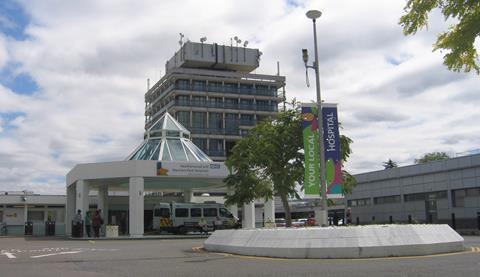The role of competition law is to test whether the reduction of choice of services is justified by the benefit to patients, and the approval of the Heatherwood-Frimley Park merger shows to clear the competition hurdles, says Gerard Hanratty

Successful reconfiguration of clinical services, following the introduction of the Health and Social Care Act 2012, has now become a test of commissioners’ ability to reconcile two different philosophical approaches battling for control over NHS.
In one corner, traditional democratic engagement and good governance with an “open mind”; while in the other, is a new order of choice and competition, which seeks to inject a “market” dynamic, which views patients as consumers of services, as well as recipients of care.
- The CMA can improve the NHS merger regime: here’s how
- Navigating a competition minefield − an HSJ roundtable
- Monitor has to walk a line between pragmatism and purism
These two opposing outlooks underpin the sometimes contradictory legal framework that governs NHS services reconfiguration: public, procurement and competition law. The overriding objective of each of these three interlinking obligations is to protect the interests of patients.
However, their different and sometimes competing obligations have created a set of processes that requires careful navigation, to ensure that commissioners do not inadvertently create legal routes to funnel political unhappiness with proposed changes to local services. This approach was demonstrated very effectively by the Save Lewisham Hospital campaign.
The four tests
The public law obligations are based in the NHS Act 2006 and set out a series of obligations in relation to how public consultations are required to be run. The most important among these are the four tests for service change: strong public and patient engagement; consistency with current and prospective need for patient choice; a clear clinical evidence base; and support for proposals from clinical commissioners. The objective of these is to ensure that commissioners reach a reasoned decision for changing clinical services.
‘The role of competition law is to test whether the reduction of choice of services available to patients is justified by the likely clinical benefits’
While the procurement law obligations, under the NHS (Procurement, Patient Choice and Competition) Regulations 2013, require commissioners to keep an open mind in relation to service reconfiguration and consider whether holding a procurement competition would be likely to improve the quality and efficiency of services.
The role of competition law is to test whether the potential reduction of choice of services available to patients, following a merger of clinical services, is justified by the likely clinical benefits.
This article looks at how commissioners can effectively negotiate a merger review process by the Competition and Markets Authority and Monitor, following the CMA’s clearance of the merger of Heatherwood and Wexham Park Hospitals Foundation Trust by Frimley Park Hospital Foundation Trust.
The most important step
The Heatherwood and Frimley case provides a model for successful and efficient competition clearance decisions (it was notified to the CMA in March and cleared in May). This case shows how the CMA and Monitor are working effectively together, in line with their joint statement on collaborative working published in October. It also demonstrates that a considerable amount of learning has taken place since the Competition Commission blocked the merger of the Bournemouth and Poole Foundation Trusts in October.
‘It is important that the parties to an NHS merger are able to clearly and succinctly articulate the rationale for the merger’
The single most important step NHS Trusts can take before entering into detailed merger discussions is to undertake a forensic examination of the extent of competition between them and assess the likely impact of the merger on existing healthcare competition. The outcome of this examination should then be central to a decision on whether it is sensible to proceed with a planned merger and engage in discussions with the CMA and Monitor.
The CMA will consider the effect of competition on each medical speciality and will assess both competition in the market and competition for the market. Competition in the market is competition for patients and occurs when patients have a choice between providers of the same services; whereas competition for the market refers to competition to attract contracts from commissioners to provide services.
In its assessment of competition in the market the CMA will assess the extent of overlapping services between the parties and third party providers; for example, do both trusts provide specialist HIV services and what will be the implications for the quality of these services if the trusts merge? The CMA will also analyse GP referral patterns, to examine the extent to which the parties are GPs’ first and second preferred providers of services.
Rationale for mergers
In reviewing competition for the market, the authority will consider whether or not potential reconfiguration of services by commissioners is likely to occur (for example by holding a procurement competition), and if so whether the merger is likely to create a loss of competition in relation to such reconfiguration. Therefore, it would be sensible to analyse which commissioner’s tenders the parties have responded to and also obtain as much information about commissioners’ plans for reconfiguration before the merger, so a realistic assessment can be made on the likely impact the merger will have on these plans.
Before any engagement with the competition authorities, it is important that the parties to an NHS merger are able to clearly and succinctly articulate the rationale for the merger and why it is in the interests of patients.
This rationale will form the basis for all discussions with the competition authorities, and third parties, and inform a future merger submission to the CMA and a potential “patient benefits” case submitted to Monitor. The rationale for the Heatherwood-Frimley merger was that Heatherwood and Wexham Park is a struggling FT and the quality of its services has deteriorated over time.
The decision on whether to submit a formal patient benefits case to Monitor in support of the merger is optional. This assessment mirrors the “relevant customer benefits” reviewed by the CMA in non-healthcare mergers. In cases that are unlikely to result in a “significant lessening of competition” the parties may decide that there is no need to do this, as in the Heatherwood-Frimley decision.
Public choice
Nevertheless, the parties should have a very clear idea of what the potential benefits to patients will be over a reasonable timeframe, as they are likely to need to explain these in a robust dialogue with the CMA and Monitor. They should also give detailed consideration to why they cannot achieve these benefits through arrangements other than a merger, for example, through the coordination of clinical rotas.
The types of patient benefits that providers previously submitted to Monitor’s Cooperation and Competition Panel and the CMA are higher quality services through: 1) implementing a particular model of care across both trusts; 2) consolidating services on a single site; 3) increased consultant or staff cover and access to equipment; 4) greater innovation through research and development and greater ability to attract funding for research and development; and 5) financial savings through, for example, making more efficient use of clinical equipment or sharing back-office functions.
‘The Heatherwood-Frimley decision provides an effective example of the route for successfully clearing the competition hurdles’
A reasonable timeframe will vary in relation to the nature of the proposed benefit and the circumstances of its implementation. For example, a large building project or merger of a maternity or accident and emergency service may require a longer period for benefits to patients to be realised than a smaller project.
Finally, the CMA’s consideration of relevant customer benefits has not, as yet, resulted in an unconditional clearance of a merger but there are cases where Monitor has allowed hospital mergers to proceed unconditionally despite considering that competition and choice would be adversely affected, for example, in the Competition and Cooperation Panel’s 2011review of the proposed merger of Oxford Radcliffe Trust and the Nuffield Orthopaedic Centre Trust.
Mergers of NHS hospitals have the potential to considerably alter the choice of health services available to the public, and consequently the competition authorities will undertake a robust analysis of any merger proposal to ensure that the effects of a merger are pro-competitive, or at least competition neutral.
The Heatherwood-Frimley decision provides an effective example of the route for successfully clearing the competition hurdles. Most importantly, the parties in an NHS merger should examine the extent of competition between them and the likely impact of the merger on this competition, while also developing a robust understanding of the likely patient benefits, and why these cannot be achieve by any other route.
Gerard Hanratty is partner at Capsticks. He is speaking today at the the Commissioning Show.



























No comments yet